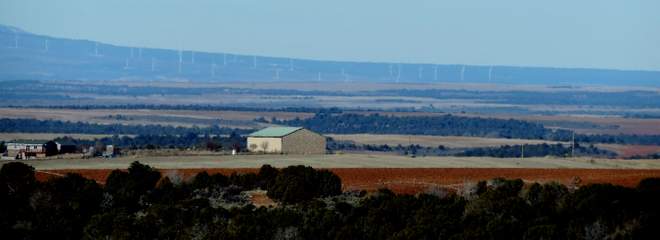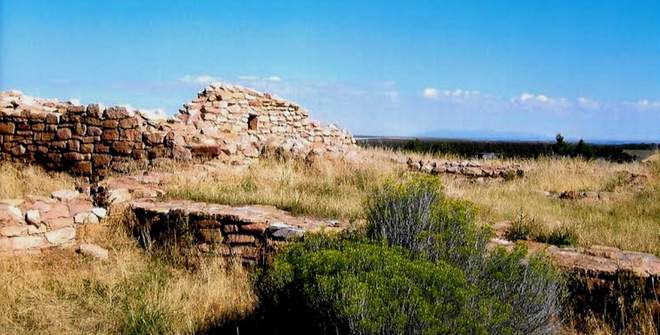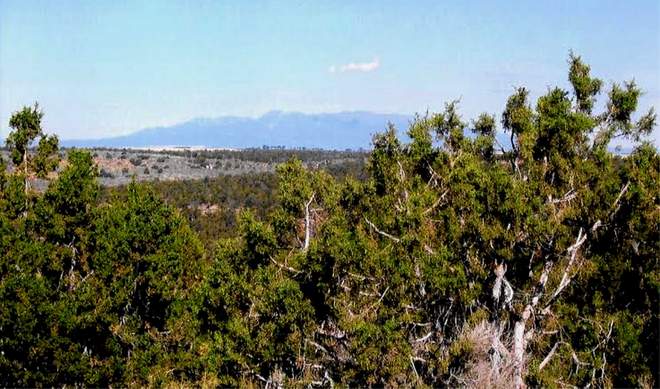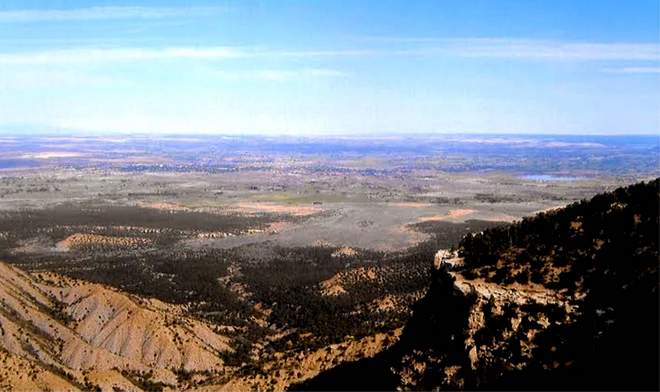Where there is no vision, the people perish. – Proverbs 29:18
The ancient pueblo ruins at the Lowry archeological site are about nine miles due west of Pleasant View, Colorado, and they go back to 1060 C.E. They lie on the edge of the Canyons of the Ancients National Monument atop a low, spreading hilltop on the Great Sage Plain. The Plain once served as an expanse of contoured, high elevation farmland for numerous ancient pueblos. A fertile, favored place, it nurtured the ancient pueblo Indians, the Hisatsinom, even during rain-scarce decades.
The 40 room pueblo at the Lowry site was inhabited for about 165 years and includes an extraordinary Great Kiva. These ruins sit among sagebrush, rabbitbrush, and Utah Juniper, and are dotted with Pinyon pine and a hardy species of prickly-pear cactus. And the site enjoys a sharp, splendid view of the Abajo Mountains about 35 miles to the northwest.
Standing within the circumference of that enormous kiva is humbling.
A plenitude of these ancient Hisatsinom pueblo sites have been massively pored over and studied by archeologists. Beyond that, the Hisatsinom are clearly related to the contemporary pueblo tribes of New Mexico and the Hopi in Arizona. Nevertheless, we in the mainstream culture may never discover what the worldview of the Hisatsinom actually was. We may never have more than a fragmentary understanding.
Yet something we have been able to share with them, despite the passage of eight or more centuries, at least in certain locales, is their profound love of landscapes. When I stood out at the western edge of the Lowry pueblo, gazing at the sharp relief of the Abajo Mountains, I understood on a sensory level at least one of the reasons they chose this site. You could feel that that they took joy in walking those few steps away from the pueblo’s masonry to join with the long, open sky and the untrammeled mountains. And while it certainly took me a lot longer to travel to that very spot, on this day I shared that particular happiness which they knew.
But no more. That thread of connection with the Hisatsinom; the subtle way every visitor to the site has had of knowing them, has been severed by the massive Latigo Wind Project.
Which consists of 27 gigantic wind turbines, now under final construction just north of the town of Monticello, Utah, and abutting the northern slope of the Abajo Mountains. Given the site’s base elevation of up to 7,800 feet, it stands above vast stretches of lower ground running far to the southeast, east, and northeast in Western Colorado, certainly including the Lowry site and the nearby town of Pleasant View.
Compare the photograph of the many wind turbines readily visible from the village of Pleasant View with the two photographs of the Abajo Mountains that I took from the Lowry site in 2012, bearing in mind that the latter is actually closer to the turbines than Pleasant View itself. Those wind turbines are visible from where the Hisatsinom once stood.
In fact, these gargantuan turbines are likely visible as far away as Mesa Verde National Park, nearly 60 miles from Latigo to the southeast. See the photograph of one of the turbines under early construction with Wetherill Mesa in the background, much of which is inside Mesa Verde National Park. Also see my 2012 photograph from an overlook at the far northwestern edge of the Park looking across much of the vast Great Sage Plain angling to the northwest. If those wind turbines are not now visible from this overlook – well, it’ll be a surprise to me.
Nor are we just talking about them being visible in the daytime: a significant number will be strung with flashing red lights, like a perverse Christmas tree, to warn airplanes of their looming presence at night. These are lights that will be visible at enormous geographic distances.
As Jim Stiles has said, “When completed, this wind farm may be the most visually intrusive wind turbine cluster in the United States.”
Yet many will shrug and say, “So what?” And add that what we need more than anything else is renewable energy on a large enough scale to replace fossil fuels, which makes the Latigo Wind Project not only acceptable in their minds, but the beginning of a far more intrusive presence. The underlying premise of such a response is that when it comes to a choice between prosperity as we’ve known it and mere “scenery,” the latter is expendable. “It’s just common sense,” they’ll add with a nod.
***
But the assumption that mass renewable energy can support the untrammeled consumerism we’ve known is based on the further assumption that continuing our relentless economic growth is both feasible, even with the phasing out of fossil fuels, and ultimately beneficial to the public as a whole. Over the last century these assumptions have become so ingrained within the mainstream psyche that they are more like religious dogma than an informed system of belief.
And not only is their falsity evident now, it was evident by the late 1960s to none other than Edward Abbey: who at that time challenged the relentless expansion of paved roads in national parks and monuments. Questioning the viability of the massive expansion of renewable energy at this time is in every way parallel.
Abbey challenged the impact of unremitting economic expansion on the spiritual solitude of wild lands in his brilliant chapter, “Polemic: Industrial Tourism and the National Parks” in Desert Solitaire, published in 1968. Let me summarize the key scene in this chapter. In the late 1950s Ed was serving as a park ranger in the then isolated Arches National Monument when he encountered a three-man crew surveying for a paved road. He knew that snaking a paved road through the heart of Arches would destroy the precious solitude that the place offered; its true value. He also knew that the automobile and commercial tourism industries were aiming such paved roads at the heart of virtually every national park and national monument in the country, and that the same loss of wildness would likely follow each paved road. The rationale for them all, of course, was giving the public access and the motivation for them all, of course, was making piles of money.
He realized, as so many didn’t, that those who were bound to profit didn’t give two hoots about the public’s well-being.
As they don’t now.
Let me quote what Ed had to say first about the road crew’s chief and then some of his comments following: “He was a pleasant-mannered, soft-spoken civil engineer with an unquestioning dedication to his work. A very dangerous man…look, he said, when this road is built you’ll get ten, twenty, thirty times as many tourists in here as you get now. His men nodded in solemn agreement, and he stared at me intently, waiting to see what possible answer I could have to that.
“‘Have some more water,’ I said. I had an answer all right but I was saving it for later. I knew that I was dealing with a madman.”
…
“There may be some among the readers of this book, like the earnest engineer, who believe without question that any and all forms of construction and development are intrinsic goods, in the national parks as well as anywhere else, who virtually identify quantity with quality…There are some who frankly and boldly advocate the eradication of the last remnants of wilderness and the complete subjugation of nature to the requirements of – not man – but industry. This is a courageous view, admirable in its simplicity and power, and with the weight of all modern history behind it. It is also quite insane….” (pp. 44, 47, Touchstone, Simon & Schuster).
Ed’s use of the word “insane” here makes sense insofar as he is describing a profoundly destructive frame of reference that isn’t perceived as such. My own hopefully respectful expression for it is “terminal pragmatism.” For me the mild-mannered civil engineer he called a madman was a terminal pragmatist – and how.
What I mean is this. Such a person is typically a professional, executive, or politician, or the like, who as a result of her or his skills exercises a significant degree of influence or authority, is well enculturated into the society, represents its thinking and values, and who is a solid, sensible decision maker. And typically is damn good at getting things accomplished that are seen as significant.
And who is as blind as a sonar deprived bat to the advent of a new paradigm and, more importantly, to the need for and inevitability of one.
Let me be careful to add that I’m not trying to knock their considerable skills and abilities as such. The problem instead is a self-reinforcing imbalance within our culture that as individuals they are unable to see through. It was a cumulative lack of vision that sent our mild mannered civil engineer into Arches National Monument to do that job in the first place. As well as his own blindness to its implications.
I think it’s likely that a significant number of terminal pragmatists are hugely ambitious people and addicted to power, money, and the like; which of course amplifies their unwillingness to see. But to be fair, many, many others are modest and kind-hearted, happy enough with being a competent professional or skilled at a job and the comfortable lifestyle which goes with that. Probably our mild mannered civil engineer was one of the latter.
My conclusion is that marring the solitude of the land by systematically pocking it with large-scale wind farms and solar plants is no different in principle than paving it over with roads that invade nearly every wild place. I believe they’re congruent symptoms of the same malady. And that this is precisely what terminal pragmatists, even those who perceive themselves as environmentalists, cannot or will not see.
It’s my best guestimate that the investors, engineers, and builders of the Latigo Wind Project, as well as its many supporters, are basically terminal pragmatists. As are, for that matter, the politicians who negotiated the 2009 Copenhagen and 2015 Paris climate agreements, with their toothless, upbeat goal statements and unwillingness to envision the best climate science unfettered by the typical – and immensely profitable to some – political and economic assumptions.
Visionaries in the best and necessary sense, as Ed Abbey was, are not so much rare in our culture as they are unheard – and unseen. Meanwhile the terminal pragmatists are, frequently with the best of intentions, running us aground as efficiently as their considerable skills allow.
***
A final thought. Our relationship with the landscapes that surround us is as much emotional, poetic, and spiritual as it is rational and economic. That is why the so often disparaged “tree huggers,” those nature lovin’ intuitive goofballs, may be the most emotionally and spiritually healthy among us. And it is likely that the way they look at the world, perhaps I should say envision it, is crucial for the ultimate survival of our species. Yet the dominant society, utterly in sync with global economic power systems and staffed to the gills with good terminal pragmatists, regards only the latter two, the rational and economic aspects, with any level of seriousness.
Meanwhile numberless thousands of people are and will be stuck with watching those huge, twirling Latigo wind turbines ruin some of the loveliest landscapes in our country.
Note: actually, bats are not blind: they use echolocation, analogous to sonar, to hunt insects in the dark. See http://www.bats.org.uk/pages/echolocation.html
All photos courtesy of the author.
SCOTT THOMPSON is a regular contributor to the Zephyr.
He lives in Beckley, WV.
To read the PDF version of this article, click here.
To comment, scroll to the bottom of the page.
Don’t forget the Zephyr ads! All links are hot!

















If you get the impression that wind turbines are too huge and kludgy to be green, Germany offers proof. Inefficiencies are evident when mammoth structures are needed for relatively small generators. Imagine a bird that big and heavy trying to sustain itself naturally.
Germans have built over 30,000 turbines and America would need about 826,000 to match that density. For all of it, Germany’s CO2 emissions haven’t fallen, yet they persist with an Energiewende scheme that’s defaced much of their countryside. Fanatical to the end, apparently. This wind farm map from only 2011 is staggering to view:
https://en.wikipedia.org/wiki/Wind_power_in_Germany#/media/File:Windkraftanlagen_in_Deutschland.png
If America tries to top that scenario we’re truly insane, with or without Trump, who happens to be right on this particular issue.